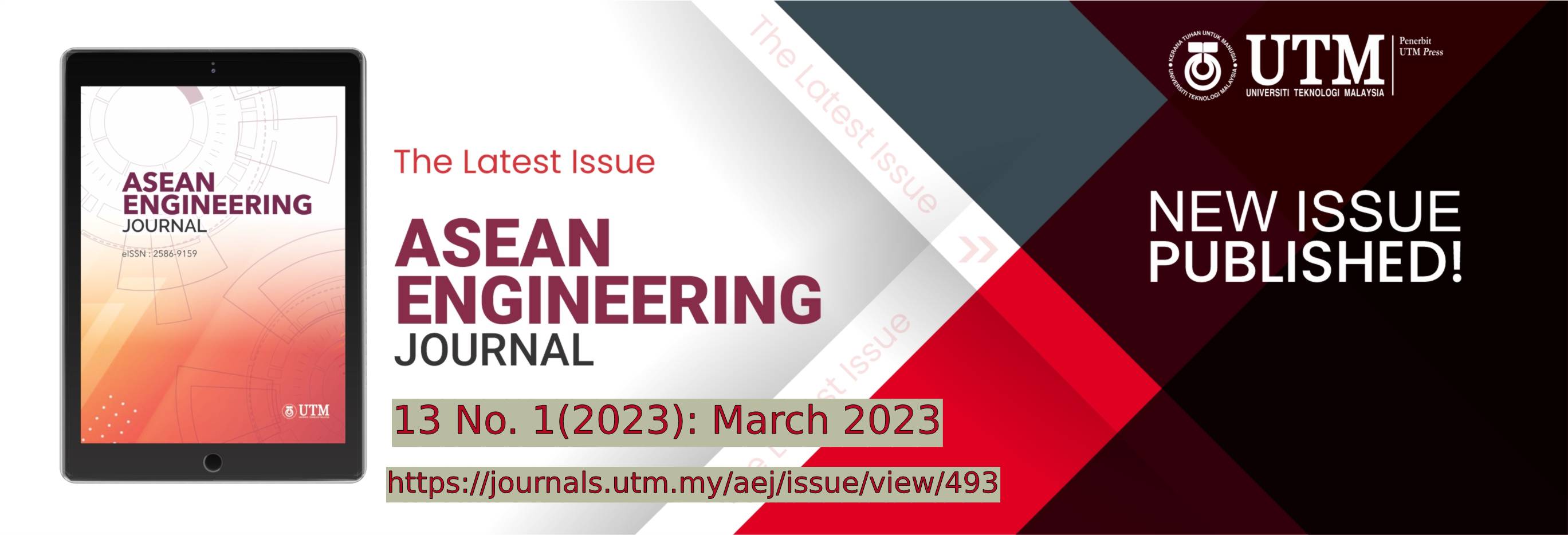LIGHT-TRANSMITTING CONCRETE PROPERTIES OF SHORT WALL PANEL
DOI:
https://doi.org/10.11113/aej.v13.18433Keywords:
Light-transmitting concrete, Plastic optical fiber, Self-compacting concrete, Axial load, Fiber configurationsAbstract
Consideration of fiber configuration and the distance between the light source or light meter and the LTC specimen in the previous studies is still limited. The incorporation of plastic optical fiber (POF) into concrete with fiber configurations of 5 ´ 5 and 6 ´ 6 grids is investigated in terms of short wall panel application to study its light intensity and strength properties. The light-transmitting concrete (LTC) short wall panel of 300 mm wide ´ 400 mm high ´ 75 mm thick is cast using self-compacting concrete (SCC) to ensure the flowability of the concrete during mixing. The fresh SCC is tested under slump flow, V-funnel, and L-box to verify its fresh properties, while compression test is carried out at 28-days on cube specimens to determine its compressive strength. Then, light transmittance and axial load test under compression are conducted for the LTC wall panel. The findings show that the light intensity of the LTC wall panel increased with the increased number of fiber configurations. However, regardless of fiber configurations, the light intensity reduced with the increase of both light source and light meter distances. In addition, the ultimate axial load of the LTC wall panel with fiber configurations of 5 ´ 5 and 6 ´ 6 grids are 662 kN and 643 kN, respectively. It implies that the fiber configuration does not affect the axial compression load. Furthermore, both LTC wall panels failed solely under pure compression load.
References
Tuaum, A., Shitote, S. M. and Oyawa, W. O. 2018. “Experimental Evaluation on Light Transmittance Performance of Translucent Concrete”. Journal of Applied Engineering Research. 13(2): 1209-1218.
DOI: http://www.ripublication.com/ijaer18/ijaerv13n2_51.pdf
Elghezanwy, D. and Eltarabily, S. 2020. “A Review of Translucent Concrete as a New Innovative Material in Architecture”. Civil Engineering and Architecture. 8(4): 571-579. DOI: http://dx.doi.org/10.13189/cea.2020.080421
Sobo, C. A., Farooq, S. and Azhar, S. 2021. “Plastic Fiber Optics Embedded in Concrete (To Study its Light-Transmitting Properties) for Sustainable and Economical Buildings”. Mehran University Research Journal of Engineering & Technology. 40(2): 399-414. DOI: https://doi.org/10.22581/muet1982.2102.14.
Altlomate, A., Alatshan, F., Mashiri, F. and Jadan, M. 2016. “Experimental Study of Light-Transmitting Concrete”. International Journal of Sustainable Building Technology and Urban Development. 7(3-4): 1-7. DOI: https://doi.org/10.1080/2093761X.2016.1237396.
Huang, B. and Lu, W. 2020. “Experimental Investigation of the Multi-Physical Properties of an Energy Efficient Translucent Concrete Panel for a Building Envelope”. Applied Sciences. 10(19): 6863. DOI: https://doi.org/10.3390/app10196863
Shen, J. and Zhou, Z. 2020. “Light Transmitting Performance and Energy-Saving of Plastic Optical Fibre Transparent Concrete Products”. Indoor and Built Environment. 30(5): 635-649. DOI: https://doi.org/10.1177/1420326X20903368
Zhou, Q., Zhang, P. and Zhang, G. 2014. “Biomass and Pigments Production in Photosynthetic Bacteria Wastewater Treatment: Effects of Light Sources”. Bioresource Technology. 179: 505-509. DOI: https://doi.org/10.1016/j.biortech.2014.12.077
Kumar, A. and Ahlawat, R. 2017. “Experimental Study on Light Transmitting Concrete”. International Journal of Innovative Science, Engineering & Technology. 4(6): 201-210. DOI: http://ijiset.com/vol4/v4s6/IJISET_V4_I06_25.pdf.
Henriques, T. d. S., Dal Molin, D. S. and Masuero, Â. B. 2020. “Optical Fibers in Cementitious (LCTM): Analysis and Discussion of their Influence when Randomly Arranged”. Construction and Building Materials. 244: 118406. DOI: https://doi.org/10.1016/j.conbuildmat.2020.118406.
Sawant, A. B., Jugdar, R. V. and Sawant, S. G. 2014. “Light Transmitting Concrete by Optical Fiber”. International Journal of Inventive Engineering and Sciences. 3(1): 23-28. DOI: https://www.ijies.org/wp-content/uploads/papers/v3i1/A0558123114.pdf.
Salih, S. A. and Joni, H. H. 2014. “Effect of Plastic Optical Fiber on Some Properties of Translucent Concrete”. Engineering and Technology. 32, Part A (12): 2846-2861. DOI: https://www.uotechnology.edu.iq/tec_magaz/2014/volum322014/No.12.A.2014/Text(1).pdf
BIBM, CEMBUREAU, ERMCO, EFCA and EFNARC. 2005. EFCA. The European Guidelines for Self-Compacting Concrete. Specification, Production and Use. DOI: http://www.efca.info/download/european-guidelines-for-self-compacting-concrete-scc/?msclkid=def86202a53e11ec8bab1229a6a354b7.
Walraven, J. 2003. “Structural Aspects of Self Compacting Concrete”. The 3rd International RILEM Symposium on Self-Compacting Concrete. Edited by O. Wallevik and I. Nielsson. RILEM Publications SARL Reykjavik, Iceland: 15-22.
British Standards Institution. 2010a. Testing Fresh Concrete – Part 8: Self-Compacting Concrete: Slump-Flow Test (BS EN 12350-8). London.
British Standards Institution 2010b. Testing Fresh Concrete – Part 9: Self-Compacting Concrete: V-Funnel Test (BS EN 12350-9). London.
British Standards Institution 2010c. Testing Fresh Concrete – Part 10: Self-Compacting Concrete: L-box Test (BS EN 12350-10). London.
British Standards Institution. 2009. Testing Hardened Concrete – Part 3: Compressive Strength of Test Specimens (BS EN 12390-3). London.
Li, Y., Li, J., Wan, Y. and Xu, Z. 2015. “Experimental Study of Light Transmitting Cement-Based Material (LTCM)”. Construction and Building Materials. 96: 319-325.
DOI: https://doi.org/10.1016/j.conbuildmat.2015.08.055.
Robles, A. Arenas, G. F. and Stefani, P. M. 2020. “Light Transmitting Cement-Based Material (LTCM) as a Green Material for Building”. Journal of Applied Research in Technology & Engineering. 1(1): 9-14.
DOI: https://doi.org/10.4995/jarte.2020.13832.
British Standards Institution. 2004. Eurocode 2: Design of Concrete Structures – Part 1-1: General Rules and Rules for Building (BS EN 1992-1-1). London
















